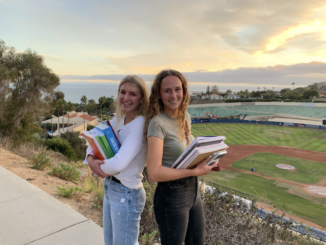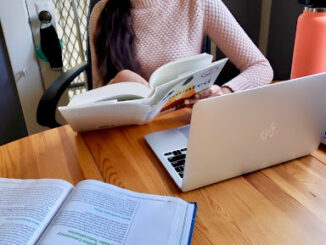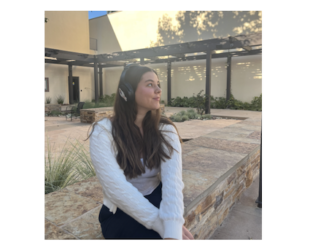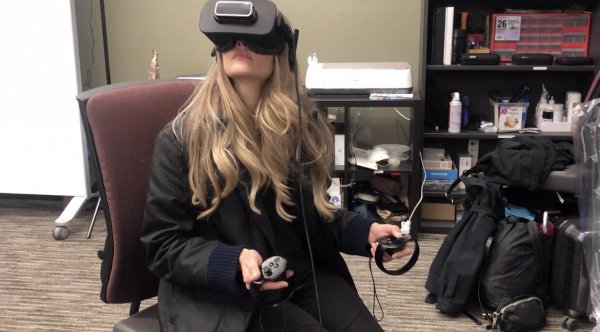
While some students use virtual reality (VR) to escape reality, how virtual reality can enhance their education is less known.
While the Payson Library Genesis Lab has hosted events and classes to encourage faculty and students to utilize its 3D printers and virtual reality gear, many students are either unaware of where the Genesis Lab is, too intimidated to go in or do not feel like virtual reality or 3D printing is relevant to their major.
“Some people come in and say, ‘Is this the Genius Lab? And we’re like, ‘Close enough, yeah!’ or they’ll say, ‘Is this the video game room?’ and we’re like, ‘Kinda, sure,’” Genesis Lab Co-Director Landon Phillips said. “Different people who have an experience here leave and tell their friends different things.”
As virtual reality and 3D printing continue to develop, experts in the field indicate that the biggest hurdle will be convincing professors to integrate the new technologies into the curriculum.
Gaging student interest
VR companies such as Sony, HTC and Facebook and 3D printers have thus far succeeded in capturing the attention of students for their entertainment value, including gaming and creating fun 3D objects.
Jane Yi, a junior computer science and digital arts major, works at the Genesis Lab and said she has observed students using VR technology more for games and 3D printing more for practical applications.
“I think a lot of people think VR is fun and they don’t see the practical applications of VR as much as they do for 3D printing,” Yi said. “We’ve had people print really cool practical stuff like this grad student was printing a syringe and a bunch of parts for actual use.”
More than 600 3D objects have printed successfully at the Genesis Lab since it opened in late 2017, Phillips said.
A Pepp Post poll of 50 students found that 94 percent think 3D printing is taking off and about 84 percent think virtual reality is taking off. Yet roughly 70 percent have not used the Genesis Lab resources.
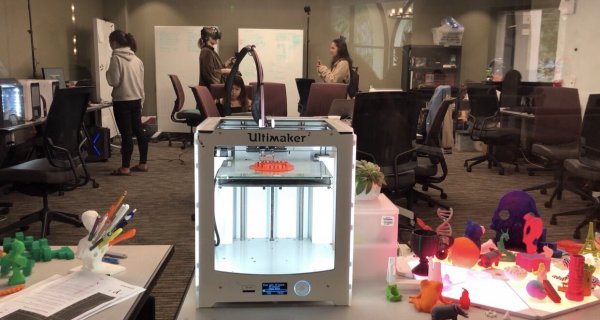
The lackluster interest from students may be that the technology is still so new. Yet this is exactly what makes it vital for people to explore VR and 3D, said Grace Kruse, a senior integrated marketing communication major who works at the Genesis Lab.
“There’s a chance it will die out if people don’t keep exploring,” Kruse said. “Gaming and art are the two big things happening with VR but there’s so much of the world still undiscovered within it because people aren’t willing to learn a skill or figure out how to program and code.”
Perceptions of VR
Many students that come into the Genesis Lab utilize the VR video games. The most popular game, Beat Saber, has logged 220 hours, Phillips said.
Despite the practical applications of VR, some students like Blake Ledna, a senior political science major, believe VR is still based in entertainment.
“I think it’s more of a trend right now in terms of video games,” Ledna said. “I do think it does have other useful aspects of it that will be used in the future.”
Senior sociology major Taylor LaFrancis said she thinks VR will get more users once it proves itself as a technology used for more than entertainment.
“If it can permeate more than just the entertainment industry, it’ll be here to stay,” LaFrancis said. “If it doesn’t have too many applications and people aren’t utilizing it in more areas of their lives, it’ll be just a fad.”
Junior IMC major Bryan Munguia said he prefers to use VR to see things he cannot see in real life.
“I’m not the video game type of guy but I do like the idea of escaping from reality,” Munguia said. “But I’m not going to go put on my VR goggles to go to Yosemite. It doesn’t feel authentic. If I’m in a really weird unknown dimension that I couldn’t see in the natural world, then that’s interesting to me.”
VR is already going beyond the video game world.
“The idea that VR and video games are a match made in heaven has largely been proven distrue,” said Anna Speth, librarian for emerging technology and digital projects at Payson Library. “There has been some uptake in games since it has become a consumer product but it is exploding with so many practical uses across so many fields.”
A lot of different businesses are using virtual reality to train employees including Walmart and Farmers Insurance. The National Football League (NFL) even uses it to train players. Virtual reality training helps prevent bias in training and gives people practice in learning muscle memory doing possibly dangerous tasks, Speth said.
Application to majors
Education is expected to be the fourth biggest sector for VR investment, according to a 2017 Virtual Reality Brief infographic.
Teachers have found VR programs like Google Expeditions and Discovery Learning especially useful for the classroom, Meredith Thompson wrote in a January 2018 The Journal article. Some school districts have also overcome accessibility issues by having students bring their own phones while the school supplies the headsets or designating a central office or classroom to share VR devices across districts, Thompson wrote.
For students in more technical Science, Technology, Engineering and Mathematics (STEM) majors, VR and 3D can help students discover a new way to approach learning.
“It adds that creative element,” LaFrancis said. “I think it’s more hands on, experiential learning that really helps rather than reading out of a textbook or sitting in class.”
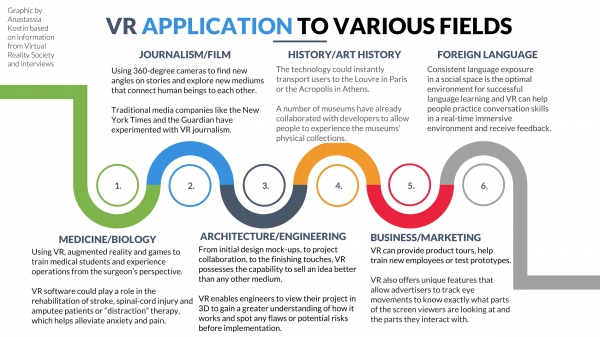
The Genesis Lab can be especially useful for education majors.
“A lot of student teachers are getting ready to graduate and makerspaces are more and more prevalent in the K-12 systems,” Phillips said. “It gives them [student teachers] an early start to planning curriculums.”
Tatum Shackleford, a junior English and education major, said her Education 464 class visited the Genesis Lab more than once to learn how VR and 3D can be applied to the classroom.
“We each had to brainstorm an idea for our individual content areas,” Shackleford said. “For English, me and my peers were considering making manipulatives [learning aids] to incorporate into our classroom. We would have the parts of speech laid out and we could make little pieces and use them for sentence diagramming.”
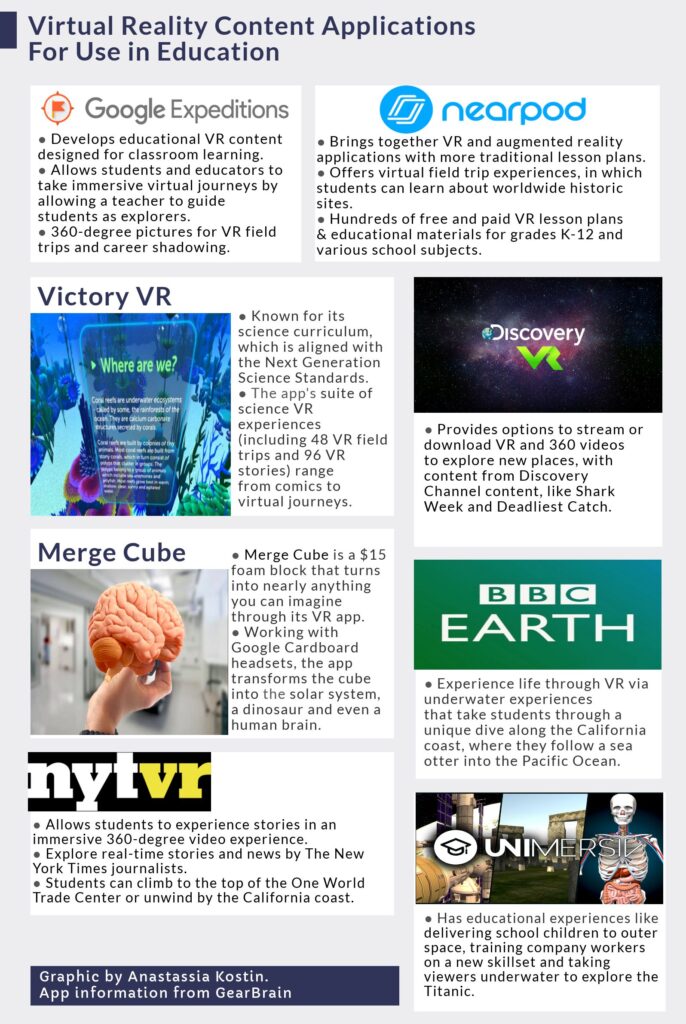
VR is also a useful tool for the hard sciences — biology, anatomy, geology and astronomy to give students a hands-on experience without using limited resources, Phillips said.
“We have some software here that can give you this Iron Man exploded view of the human body so you can turn on and off certain systems and even goes as far as seeing how different joints animate,” Phillips said. “You can’t really do that with X-rays or CTs or even with a cadaver lab.”
There are ways for VR and 3D printing to be included in a variety of disciplines.
“There’s some medical uses where they model a kidney and have stem cells grow around that model,” Kruse said. “SpaceX also uses titanium filament to create screws and different things that the way they are constructed makes them stronger so things aren’t exploding in space.”
A makerspace like the Genesis Lab is important to see where people’s creativity takes them and helps predict how the general public will use the technology in the future, Kruse said.
“There are general skills everyone can and should learn and that’s why we go to a liberal arts school,” Kruse said.
The affordability factor
Google Cardboard, which ranges from $10 to $30, allows people to explore VR with most Androids and iPhones. It has been instrumental in providing inexpensive, fun and accessible virtual reality experiences, Jason James wrote in a September 2016 Informatics Innovation Unit article. More elaborate headsets, including the Oculus Rift, Sony Playstation VR and HTC Vive, run between $399 and $499, according to PC Magazine.
Shackelford said a school’s budget, and whether the school is public or private, determine whether the school has the money to incorporate VR.
“It also brings up the question of, ‘Is it equitable?’” Shackelford said. “Students who have iPhones are able to use the Google Cardboards but students who have phones that may not be that up to date or if they do not even have a phone might not be able to participate.”
Digital Arts Professor Kate Parsons teaches the Art 420 class, a fairly new course that incorporates basic animation techniques with VR. Her class visits the Genesis Lab at least once a week to supplement what students are doing in class. For example, students will make a flipbook and then visit the Genesis Lab to use Quill software to animate it and paint in a 3D space.
“The main problem is educating whoever is writing the checks that it’s justifiable,” Parsons said. “They’re [headsets] expensive but they’re worthwhile and it’s where things are headed. If they do want to have the latest, greatest cutting-edge technology, they’re going to need to spend a bit of money to get that.”

Parsons said she is currently submitting grants to get an art and tech lab at Pepperdine with more VR headset equipment for students. While there was just enough funding this semester to get a headset that connects to a PC computer for the Art 420 class, it is still not enough for the eight students in the class, Parsons said.
“The fact that Pepperdine has the Genesis Lab is amazing,” Parsons said. “There are a lot of universities that don’t have anything like that. It’s hard. You’re asking people to spend a lot of money on new tech that hasn’t quite proven itself yet. I get it.”
Getting faculty on board
VR is still a new concept for Pepperdine faculty in addition to students.
Research found that about 80 percent of teachers in K-12 schools nationwide have access to virtual reality devices but these are used regularly by only about 7 percent of teachers, according to a Virtual Reality Brief infographic.
In higher education, there also exists the problem of unfamiliarity with the technology.
“It’s not necessarily obvious to some of the faculty, especially the ones used to teaching a certain way, how to integrate it,” Phillips said.
The Genesis Lab is currently partnering with philosophy, writing and marketing classes to implement VR and 3D printing into a diverse set of courses to show the technology is not just for STEM related fields.
“Part of our due diligence is to help educate them [faculty] on how this [technology] could be applied because some people’s assumptions are, ‘Oh this is an engineering thing or physics thing,’” Phillips said. “Even the students say, ‘Oh that’s so cool, I wish I could go in there,’ and we’re like, ‘You can!’”
However, there is no intention to force faculty to teach a certain way, Phillips said.
“If you are open to it, there’s probably a really unique application regardless of what you teach to engage your students with this type of technology,” Phillips said.
Some issues exist with academia at large, Speth said.
“When faculty are looking to do cutting edge research for their portfolios, stuff that tends digital is not as accepted unless you are computer science or something like that,” Speth said. “If the faculty don’t have incentive to do cutting edge research with it, then they don’t bring students on board.”
Parsons said she hopes to incorporate VR/3D into her Art 230 class and that professors of the upper division senior studio classes are also hoping to have students incorporate VR components into projects.
Introductory video classes in journalism and media production are still not making much use of the Genesis Lab but Media Production Professor John Sitter wrote in an email that he is working with two other professors in the fine arts and computer science departments to apply for grants to do VR mapping of campus.
The future of VR
Fully taking advantage of new VR technology requires learning from the past.
“The tech that has advanced even in the last three years is incredible,” Phillips said. “It used to be where even the high-end one at the time had a screen-door effect where you could see the individual pixels. That has almost completely vanished.”
Today, a lot of small VR startups are trying to get access to the fairly new market but HTC Vive and Facebook’s Oculus Rift dominate the industry, Phillips said.
“The resurgence and popularity of the maker community growing, especially in the education community, is speaking to that inner need which all of us pretty much have but have lost or forgotten over the past few years,” Phillips said.
As VR technology progresses, it will become integral for people of various fields to develop compelling use cases for it, said Caleb Kruse, product manager at VR/AR company Leap Motion.

For example, 3D printing industries in the beginning got into the stratospheric hype when Makerbot started releasing desktop 3D printers in 2009 but only now are becoming integrated into everyday life, Caleb Kruse said.
“Now we see that 3D printers are forming this core essential tool for any prototype or physical developer,” Caleb Kruse said. “That’s a really good metaphor for where VR is going. We’re not going to be constantly plugged into a VR headset but it’ll be really useful for core use cases.”
Plans for increasing student interaction
Despite its central location on the second floor of Payson Library, some Pepperdine students said the reason they have not visited the Genesis Lab is because they are unfamiliar with its purpose.
“I’m really intrigued by the idea,” Munguia said. “I just don’t find that much time in the library to utilize those types of services and I’m kind of confused by what the Genesis Lab really is.”
Others are afraid of misusing the resources.
“We have this perception that 3D printing costs a lot of money and I feel like I haven’t personally gone in my own time because I’m afraid I’m using the resource poorly or I don’t even know how to use it,” Shackelford said.
Ledna said he would be more open to visiting the Genesis Lab if it was not so intimidating.
“Glass walls,” Ledna said. “Everyone can see me.”
These feelings are all too familiar for Grace Kruse.
“Before [working at the Genesis Lab], I never 3D printed anything in my life or tried VR,” Kruse said. “I didn’t come in with this thinking of, ‘This is what I love’ but it’s turned into something really cool.”
Grace Kruse said workshops typically get a turnout of 20 to 30 students.
Popular events like VR game nights and the DIY Christmas sweater decorating event, which attracted about 60 students, are a great way for students to get over their initial fear of trying VR or 3D printing, Speth said.
“Sometimes you just need someone to be like, ‘I know it’s goofy to put this headset on your face but you can make these amazing cool things and you should come see,’ ” Parsons said.
This past summer, Phillips attended a conference at Stanford about using makerspaces in higher education. Phillips said VR programs such as those at Stanford do a great job of helping students get over their initial fear of making stuff.
“What really inspired me was they had separate makerspaces that were in common areas or places that you didn’t have to be a specific major to access,” Phillips said. “They were designed for just like, ‘What’s the easiest way to get anybody to just make something?’ Because there’s something inherently satisfying about making something.”
Future plans for the Genesis Lab include moving to a larger area and incorporating technologies like laser cutters and better VR equipment. However, justifying more resources for this depends on students and faculty showing interest, Phillips said.
“Pepperdine has a problem with people not realizing how much free time they actually have,” Grace Kruse said. “When iOS 12 came out [the weekly screen time report], I thought, ‘If I have nine hours to be on social media, I have nine hours to invest in something I care about.’”
The greater goal, it seems, is not just to incorporate VR into education but also to inspire students to keep exploring.
“Don’t stop after that one workshop,” Grace Kruse said. “Keep questioning and trying things and explore the possibilities. Take it one step further and see how you can apply it to your interests and what you care about.”
Anastassia Kostin completed the reporting for this story under the supervision of Dr. Christina Littlefield and Dr. Theresa de los Santos in Jour 241 in spring 2019. Dr. Littlefield supervised the web story. Dr. de los Santos supervised the video package.


